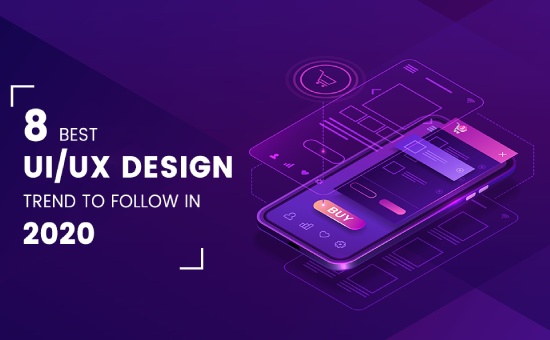8 Best UI/UX Design Trends to Follow in 2020
User Experience (UX) | Jun 08, 2020
Ahead 2020, you need to be aware of the ton UI/UX design trends you should follow. But let’s first take a quick look at what is UI and UX design.
The first experience of a mobile device is the UI interface. It links users with a mobile app design company which efficiently flattens user interaction with the device, and increases the application’s entire ROI. When the UI architecture of an app is customer-centric and has entertaining content, nothing can impede its progress.
UX’s world is increasingly changing though – different developments are emerging from time to time. And UI architecture is the most changing field of the smartphone industry, impacting many other areas of the industry.
An app’s UI architecture isn’t limited to its looks. The data architecture of the application should be combined successfully with UI design guidelines which organize the structure and mark the content sustainability and accessibly of an app.
Related Article: UI/UX Trends for eCommerce Startups in 2020
Now! It’s time to check the best 8 mobile app UX practices of 2020.

The Top 8 Mobile App UI/UX Design Trends of 2020:
1. Full-screen Smartphones
Most phones lacked their limits and had a rounded bottom. This does also alter the GUI. This will offer programmers the challenge of using quick components of the smartphone user experience and the architecture of mobile devices.
Additionally, the iPhone no longer has the keys on the homepage and Android phones lack the buttons on the screen to make room for the displayed content. Navigation relies on a display for a cleaner screen which may also be the face of a designer. It is an important move for consumers to develop new competencies. Consequently, visual indications need to be added or adjusted to help them know the dynamics.
2. Dark Themes
A few years ago also the dark theme was quite popular. Apple provided a great deal of help in that direction when it released a Mojave update that could automatically set a dark theme for its supporting apps. Besides this, they have launched an iOS update that offers similar features in dark mode.
Obscure user interface styles will grow in 2020. Beyond superficial appeal – one of the most important benefits is that dark looks with sufficient contrast can reduce eye pressure for certain individuals. Gmail is one of the new big dark remedy apps that launched the alternative again in September month.
Related News: Facebook Dark Mode for Android, iOS and Desktop Sites
3. 3D Graphics and Animation
Animation and 3D graphics are not new to user interface design. Its frequency has grown across several product categories in recent years. These products have been leveraged especially by AR and VR apps for items like viewing furniture in the actual rooms. Another recent example is the availability of 360-degree products which have become popular on numerous eCommerce websites.
If the architecture of the UI has to be extremely visible, then 3D graphics is a perfect way to do so. Animation provides an interface with a visual appeal. Although these effects take longer than 2D iterations and require a specific ability set, in situations where they are appended to the overall user interface they are worth the extra time.
4. Device-agnostic Experience
Everyone is purchasing more mobile apps. Statista estimates there will be about 6.58 networked devices per human worldwide by the year 2020. It’s shifting the way people navigate information. It is normal to change from one device to a different one.
Often, programmers will step outside of the box, as the classes “have a screen” and “portable” are not enough. Consulting on the experience of the customer is a much more efficient outcome in creating a product the computer doesn’t care about. This way, however, users would have a smooth user interface.
5. Unique Micro-interactions
Micro-interactions are an integral part of every successful digital product design. But it is still neglected by many mobile app Design Companies.
Besides this, micro-interactions give users additional input and perspective. This can include items such as color variations to display various conditions, immersive graphics, and smartphone phone haptic input. Micro-interactions, however, may also facilitate the concept from practical to exceptional.
6. Password-less Experience
Exactly retrieving passwords becomes more complicated with the use of many applications daily. The Intel Security Survey 2016 reveals that at least once a week 37 percent of users lose their passwords. Password-free authentication strategies are expected to be more widespread in the year 2020.
There are several forms of password-less authentication that are already being used in various smartphone apps. For eg, biometric (facial or fingerprint recognition) authentication. Additionally, the one-time password used in eBay and the login link used in Medium also called short term passwords.
7. Storytelling
One of the best remains in the development of being able to tell great stories about digital experiences. The print itself will shape a strong pyramid for the image. A very important part of the user interface, it plays a significant role in making an excellent user experience comes along. The creation of UI/UX design trends and practices by itself in the year 2020 – Text style is not enough.
Ad writing has been and will continue to be, one of the most critical aspects for better user interaction over the coming year. While this style absorbs the user’s interest, the plot focuses on the brand as it lets them feel like part of the story. That, in effect, only prevents users from scanning the content.
8. Voice Interactions
Once Speech Communications are held with the realm of science fiction. Today, smartphones have changed everything, making voice contact not only possible but the norm as well. Enabling users to engage with the Software with voice commands opens up a world of product interactivity.
If a consumer may receive voice instructions, he or she can use a smartphone device in circumstances where the touch interfaces are dangerous or inefficient – such as following a recipe, driving, or instructional program. The voice interface isn’t unique but the early versions were rough and mostly didn’t perform well.
Conclusion:
With all-new developments mentioned above, it is important to note that the goal of the designer will remain the same: to use modern strategies and technology to better the lives of consumers.
Through when you evaluate a particular pattern, consider it for having the best possible user experiences in the light of the benefit it provides for users.





